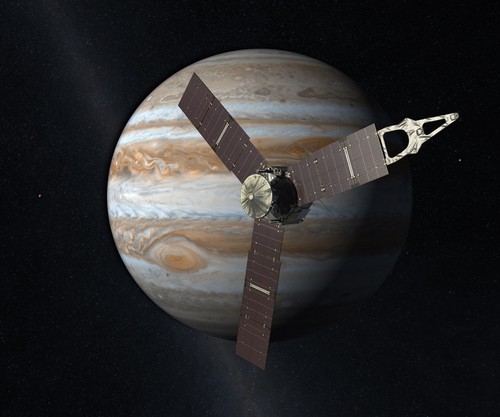NASA's Juno space probe has just entered Jupiter's orbit on Monday after a long 5-year journey, joining a party of other several unmaned spacecrafts such as Cassini and New Horizons gathering data from planets and other space objects.
Juno is currently the farthest spacecraft from Earth that operates on solar power, according to a tweet by NASA. Named after Jupiter's sister and wife in Roman mythology, its wingspan is around the size of an NBA court. It will orbit the gas giant 37 times over the next 20 months to study its water, gravity, and the Great Red Spot, according to The New York Times.
It has joined a plethora of other unmaned spacecraft monitoring data about solar systems, planets, moons, and stars. Reportedly, Juno's fate after accomplishing is mission is not to return to Earth, but to crash on Jupiter itself, which is the same as other space probes that have been sent to space without the intention of returning to our planet.
The Japanese orbiter Akatsuki, which means "daybreak" in Japanese, has been orbiting Earth's sister planet Venus, also known as the morning star. Its mission is to study its weather patterns and volcanic activities.
Among the others, one of the most popular space probes are NASA's Voyagers 1 and 2. Voyager 1 was launched in 1977 primarily to explore Jupiter and Saturn, but it now to continues to travel in interstellar space, making it the farthest man-made object from our planet.
It contains a "golden record" inscribed with images and music to provide a sampling of humankind in case extraterrestrial life forms encounter it. It is expected to exhaust its fuel supply in 2025.
Tailing it is its younger twin, Voyager 2, which is the only space probe to reach Uranus and Neptune. It is now about to exit our solar system in an area called the heliosheath.
Another one of our spacecrafts is Cassini, which arrived in Saturn in 2004 and landed on the surface of its largest moon, Titan. It is about the embark on a mission this year called the "Grand Finale", where it will dive between Saturn's innermost ring and outermost atmosphere to collect gravitational data.
Just last year, the New Horizons flew above the surface of Pluto and has provided us new data and high-resolution images of the dwarf planet. It is NASA's most recent planetary space probe achievement before Juno.



























